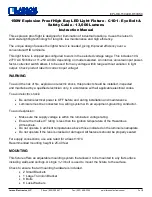
NCast Presentation Recorder Reference Manual
3. Theory of Operation
3.1. P
RESENTATION
R
ECORDER
C
OMPONENT
B
LOCK
D
IAGRAM
The Presentation Recorder consists of these main hardware functions:
Capture Hardware – A custom designed, high-performance module is used to grab and digitize the RGB
or video signals created by the presenter or media source. This module accepts VGA, Y-Pr-Pb, DVI-I, HDMI,
PAL/NTSC composite or PAL/NTSC S-Video connections and converts those signals to YUV digital format.
Two of these inputs may be active simultaneously for generation of a picture-in-picture (PIP) display.
Central CPU – A general-purpose ARM processor is used to compress and decompress audio streams,
to encapsulate and decapsulate outgoing and incoming packets streams, to enable the web interface, serial
interface and telnet interface, and to prepare data for display on the attached monitor. A highly secure open-
source operating system underlies and supports all of this functionality.
DSP – A custom DSP is used to compress and decompress YUV video and graphics images to H.264
streams.
Display Output Sub-system – Media streams, which are received and decoded, are presented on the
attached display for viewing. Both RGBHV and component output (Y-Pb-Pr) are supported.
Audio Sub-system – A sound system with stereo input-output capabilities and with support for
microphone and line-level inputs and line-level outputs is used to create the AAC audio streams transmitted
in conjunction with the associated graphics or video imagery. Balanced XLR inputs are also supported
Ethernet Interface – Industry-standard ethernet connectors are used to connect the Presentation
Recorder with the Internet network used for communications.
3.2. C
APTURE
M
ODULE
F
UNCTION
The capture module selects one of the available six inputs (VGA, DVI-D, DVI-A, HDMI, Composite, S-Video)
and locks onto the signal. The signal is converted into the appropriate digital formats, and each pixel in the
image is stored in a local memory buffer on the module. Any required sizing and re-scaling is done in the
module. At an appropriate time the pixels in module are transferred to the DSP where they are processed
and compressed.
NCast Corporation
Revision 2.2
Page 17
















































